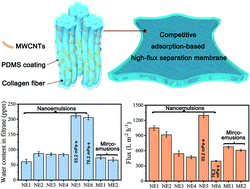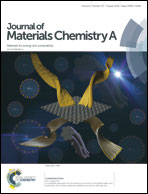Competitive adsorption for simultaneous removal of emulsified water and surfactants from mixed surfactant-stabilized emulsions with high flux†
Abstract
Simultaneous removal of emulsified water and surfactant from surfactant-stabilized emulsions remains challenging. In the present investigation, we developed a new conceptual emulsion separation membrane by using multiple walled carbon nanotubes (MWCNTs) as heterogeneous competitive adsorption-type demulsifying sites, and a 3D hierarchically fibrous structured collagen fiber membrane (CFM) as a nonporous substrate with high flux and strong mechanical strength. The MWCNTs inside the CFM served as heterogeneous demulsifying sites responsible for competitive adsorption to surfactants stabilized with emulsion droplets, which not only realized effective demulsification but also completely solved the problem of surfactant contamination in the filtrate. The nonporous substrate of the CFM ensured high separation flux and also suppressed the fouling problem frequently observed in conventional size-sieving porous membranes, which successfully separated a variety of mixed nonionic surfactant-stabilized water-in-oil nano- and micro-emulsions under gravity, with separation efficiency high up to 99.994% and flux high up to 1051 L m−2 h−1, which showed apparent advantage compared with commercial polyamide and polytetrafluoroethylene porous membranes with low fluxes of 64 and 35 L m−2 h−1, respectively. The membrane also retained high separation efficiency and flux after 10 cycles of separation or 30 cycles of strong abrasion with sandpaper. Notably, our membrane successfully separated mixed nonionic surfactant-stabilized emulsions with an extremely high viscosity of 33.2–76.2 mPa s, with separation efficiency higher than 99.98% and a high flux of 395–1299 L m−2 h−1 bar−1, while the polyamide and polytetrafluoroethylene porous membranes failed to separate these viscous emulsions.



 Please wait while we load your content...
Please wait while we load your content...